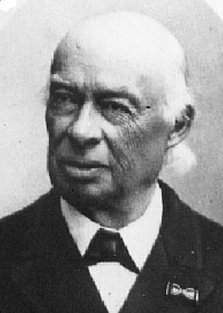
Carl Remigius Fresenius (1818 – 1897)
On December 28, 1818, German chemist Carl Remigius Fresenius was born. Fresenius is known for his studies in analytical chemistry. He devised a method for systematic identification and separation of individual metal and non-metal ions, selecting the most suitable reactions from the many that were known.
Early Years
Carl Remigius Fresenius was born in Frankfurt am Main, Germany, the son of Jakob Samuel Heinrich Fresenius, a lawyer with a doctorate in law. After attending school at the Bender Institute in Weinheim and the Lessing Grammar School in Frankfurt, he began an apprenticeship at the Steinsche Apotheke in Frankfurt in 1836. During his apprenticeship he attended lectures by Rudolf Böttger on chemistry and physics at the Physical Society. Due to his great interest in analytical chemistry, he set up his own small laboratory in his father’s garden house.
Chemistry Studies and Academic Career
Already in the second semester of his chemistry studies at the University of Bonn in 1841, he wrote his fundamental work Anleitung zur quantitativen chemischen Analyse (Guide to quantitative chemical analysis), which was published in 17 editions. After his decision to devote himself entirely to chemistry, he moved to the then Centre for Chemistry in Giessen to join Justus Liebig,[4] whose private assistant he was from April 1842 to autumn 1845. The second edition of the Anleitung zur qualitativen chemischen Analyse contained a laudatory preface by Liebig, who also introduced it as a textbook in his laboratory. In recognition of this work, the philosophical faculty awarded him a doctorate in 1842. In 1843 Fresenius habilitated as a private lecturer with a thesis on the safe quantitative determination of arsenic, until in September 1845 he was appointed Professor of Chemistry, Physics and Technology at the Ducal-Nassau Agricultural Institute on the Geisberg farm near Wiesbaden. He became the first director of the chemical laboratory which he induced the Nassau government to establish at that place. The laboratory increased in size and reputation and during the 1860s, a school of pharmacy as well as an agricultural research laboratory were added.
Further Achievements
In the spring of 1848, following the example of Justus von Liebig, he opened his chemical laboratory in a house he had bought, which was later extended by several departments and turned into a technical academy. At this chemical laboratory Fresenius Wiesbaden chemistry was taught, from 1862 also pharmacy at the Pharmaceutische Lehranstalt and from 1868 agricultural chemistry and ecology. From 1862, Fresenius was editor of the Zeitschrift für Analytische Chemie and edited it until his death. The journal produced 371 volumes and all but one of them were edited or co-edited by a member of the Fresenius family. From 1862 to 2001, the Fresenius’ Journal of Analytical Chemistry as it was known came to an end when it became Analytical and Bioanalytical Chemistry, which is still running as of 2014.
Later Life
His book Geschichte des chemischen Laboratoriums zu Wiesbaden (History of the chemical laboratory in Wiesbaden) was published in 1873. In 1852 he was elected a member of the Leopoldina Academy of Sciences. In 1875 he was admitted as a corresponding member to the Bavarian Academy of Sciences and in 1888 to the Prussian Academy of Sciences. He was a member of the Society of German Natural Scientists and Physicians.
In 1881, Carl Remigius Fresenius handed over the directorship of the agricultural research station to his son, Remigius Heinrich Fresenius (1847–1920), who was trained under H. Kolbe at Leipzig. Another son, Theodor Wilhelm Fresenius (1856–1936), was educated at Strasbourg and occupied various positions in the Wiesbaden laboratory. Carl Remigius Fresenius died suddenly at Wiesbaden at age 78, on 11 June 1897.
Peter Carr, Lecture 1 – Analytical Chemistry and Chromatography for Graduate Students, [8]
References and Further Reading:
- [1] Carl Fresenius at Carl Remigius Medical School (in German)
- [2] Carl Fresenius at Britannica Online
- [3] Carl Fresenius at Wikidata
- [4] Justus von Liebig and the Agricultural Revolution, SciHi Blog
- [5] Chisholm, Hugh, ed. (1911). “Fresenius, Karl Remigius“. Encyclopædia Britannica (11th ed.). Cambridge University Press.
- [6] Wilhelm Fresenius (2001). “One hundred and forty years “Fresenius’ Journal of Analytical Chemistry””. Fresenius’ Journal of Analytical Chemistry. 371 (8): 1041–1042.
- [7] “Fresenius, Theodor Wilhelm”. NBD. 5: 407. 1961.
- [8] Peter Carr, Lecture 1 – Analytical Chemistry and Chromatography for Graduate Students, Imad Haidar Ahmad @ youtube
- [9] Timeline for Carl Remigius Fresenius, via Wikidata





